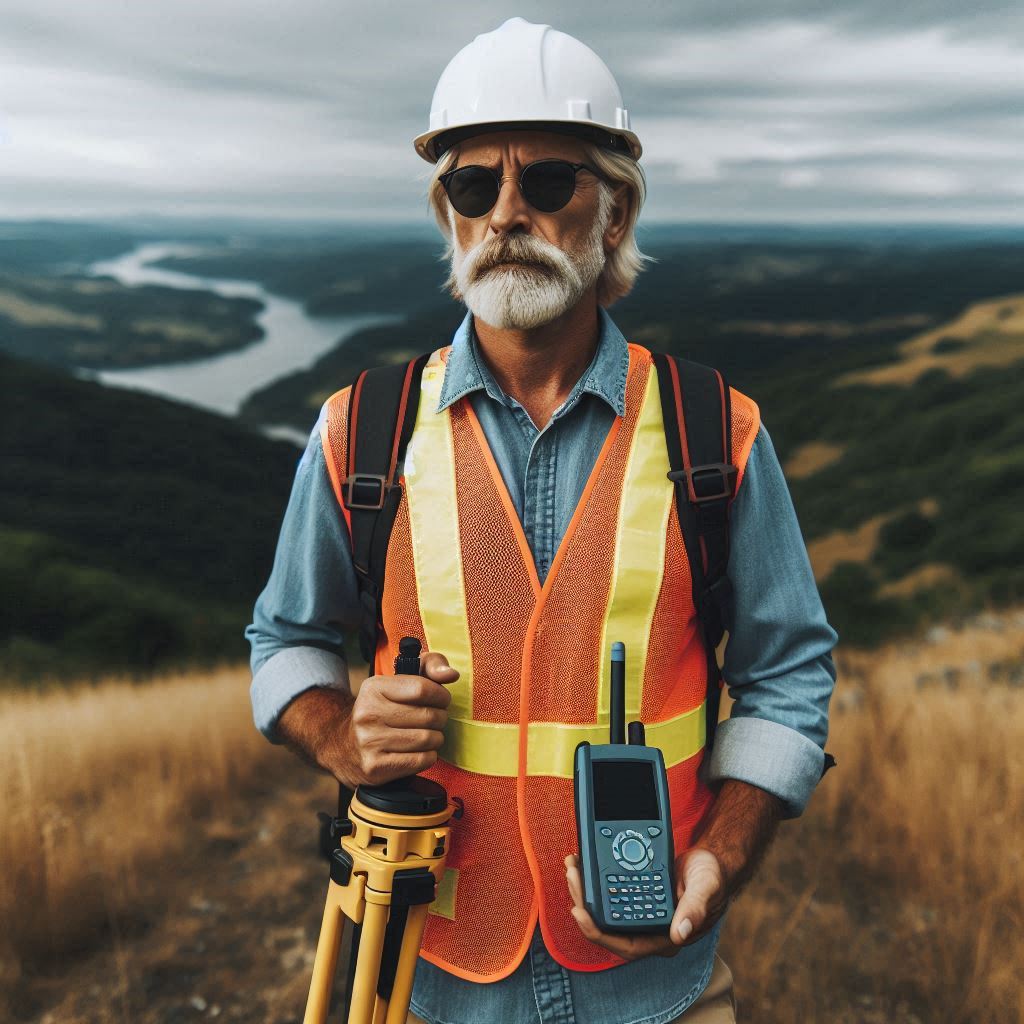Introduction
Common Challenges in Surveying and Mapping Careers
Surveying and mapping careers face several significant challenges.
Rapid technological advancements, issues with data accuracy, and frequent regulatory changes can impact professionals in this field.
These obstacles require constant attention and adaptation to maintain effectiveness.
The Importance of Surveying and Mapping Careers in Various Industries
These careers are pivotal across numerous industries, including construction, urban planning, and environmental management.
Accurate surveys and maps are essential for project success, regulatory compliance, and informed decision-making.
Their role is critical in shaping and managing the physical world around us.
The Significance of Addressing and Overcoming These Challenges for Professional Growth
Addressing these challenges proactively is key to professional growth.
Strategic planning and collaboration with industry peers offer valuable insights and support.
Engaging with professional networks can help in sharing solutions and best practices.
Staying informed about industry trends and embracing adaptability are crucial for long-term success in this dynamic field.
Embracing these strategies will enhance career resilience and effectiveness.
Lack of access to advanced technology
How the Rapid Advancements in Technology Can Pose Challenges for Professionals in the Surveying and Mapping Field
Rapid technological advancements pose significant challenges for professionals in surveying and mapping.
Emerging tools and software often become essential for precise data collection.
Professionals without access to these advancements may struggle to keep up.
They might fall behind in adopting the latest methods, affecting their efficiency and accuracy.
Specific Tools and Software That Are Crucial for Accurate Data Collection
Modern surveying and mapping heavily rely on advanced tools.
Geographic Information Systems (GIS) are crucial for analyzing spatial data.
LiDAR (Light Detection and Ranging) technology provides high-resolution, accurate terrain models.
Drones enhance data collection efficiency, offering aerial perspectives that were previously difficult to achieve.
Without access to these tools, professionals might not capture the necessary detail for complex projects, impacting work quality and accuracy.
The Importance of Continuous Learning and Adaptation to New Technologies
Continuous learning is vital in overcoming technological challenges.
Surveying and mapping professionals must stay informed about new tools and techniques.
Regular training and professional development help bridge the technology gap.
Attending industry conferences and workshops provides insights into the latest advancements.
Adapting to new technology is essential for maintaining competitiveness and effectiveness.
Professionals who do not adapt risk becoming outdated, missing out on opportunities that require modern solutions.
Investing in ongoing education and adaptation ensures that professionals remain at the forefront of their field.
Read: The Role of Aerospace Engineers in Satellite Development
Data accuracy and reliability
The Challenges Related to Ensuring the Accuracy and Reliability of Data Collected During Surveys
Ensuring data accuracy and reliability is a critical challenge in surveying and mapping.
Surveys must produce precise data to be useful for planning and decision-making.
Factors such as environmental conditions and equipment calibration can impact accuracy.
Professionals must address these challenges to deliver dependable results consistently.
Common Sources of Errors and Potential Consequences of Inaccurate Data
Common sources of errors include equipment malfunction, human error, and environmental factors.
Equipment calibration issues can lead to incorrect measurements.
Human errors, such as misreading instruments or data entry mistakes, also contribute to inaccuracies.
Environmental conditions like poor weather can affect data collection.
Inaccurate data can lead to flawed analyses and poor decision-making.
For instance, errors in land surveys can result in incorrect property boundaries or unsafe construction plans.
Tips and Strategies for Improving Data Accuracy Through Thorough Quality Control Measures
Implementing thorough quality control measures can significantly improve data accuracy.
Regularly calibrate and maintain equipment to ensure it functions correctly.
Use multiple data collection methods to cross-check results.
For example, combining traditional survey techniques with modern technologies like GPS can enhance accuracy.
Conduct frequent field checks and data validation to identify and correct errors promptly.
Establish a rigorous data review process.
Review data at different stages of collection and analysis to catch inconsistencies early.
Train staff thoroughly in data collection procedures to minimize human errors.
Encourage a culture of accuracy and attention to detail among team members.
Document all procedures and adjustments made during surveys to maintain a clear record of data collection practices.
By addressing common error sources and implementing robust quality control strategies, professionals can enhance the reliability of their data.
Accurate and reliable data is essential for successful surveying and mapping projects, ensuring that the results meet the required standards.
Read: Aerospace Engineering in Commercial Spaceflight
Project management and time constraints
The Challenges of Managing Multiple Projects Simultaneously and Meeting Tight Deadlines
Managing multiple projects simultaneously presents several challenges.
Surveying and mapping professionals often juggle several tasks, each with its deadlines.
Tight deadlines add pressure, making it difficult to maintain quality across all projects.
Balancing workloads and ensuring timely completion without compromising accuracy requires effective strategies and efficient processes.
Strategies for Effective Project Management, Including Prioritization and Time Management Techniques
Effective project management involves prioritization and time management.
Begin by assessing the urgency and importance of each project.
Use tools like Gantt charts or project management software to track progress and deadlines.
Break down larger tasks into smaller, manageable steps to simplify tracking and execution.
Establish clear milestones and deadlines for each project phase.
This approach helps in monitoring progress and making adjustments as needed.
Allocate resources wisely, focusing on high-priority tasks first.
Implement time management techniques such as the Pomodoro Technique or time blocking to maximize productivity and minimize distractions.
Regularly review project timelines and adjust schedules to accommodate unforeseen delays.
Being proactive in addressing potential issues can prevent them from escalating and impacting overall project success.
The Importance of Communication and Collaboration with Team Members to Ensure Project Success
Effective communication and collaboration are crucial for project success.
Keep team members informed about project goals, deadlines, and any changes in plans.
Foster an environment where team members feel comfortable sharing updates and discussing challenges.
Regular meetings and progress reports help in aligning efforts and addressing issues promptly.
Encourage collaboration among team members to leverage diverse skills and perspectives.
Assign roles based on individual strengths to enhance efficiency.
Use collaboration tools to facilitate seamless information sharing and coordination.
Address conflicts and misunderstandings swiftly to maintain a positive working environment.
Clear and open communication helps in resolving issues quickly and ensures that all team members are on the same page.
By implementing effective project management strategies, prioritizing tasks, and fostering strong communication and collaboration, professionals can navigate the complexities of managing multiple projects.
These practices ensure that projects are completed on time and meet the required standards, leading to overall success in surveying and mapping endeavors.
Read: The Impact of Aerospace Engineering on Modern Life

Regulatory compliance and legal requirements
The Complexities of Navigating Regulatory Frameworks and Legal Requirements in Surveying and Mapping Projects
Navigating regulatory frameworks and legal requirements in surveying and mapping can be complex.
Each project may be subject to a range of regulations, from local zoning laws to national land use policies.
Professionals must ensure compliance with these regulations to avoid legal issues and ensure project validity.
Understanding and adhering to various legal standards is crucial for the successful completion of surveying and mapping projects.
The Implications of Non-Compliance and Potential Legal Risks for Professionals
Non-compliance with regulatory and legal requirements can have serious implications.
Failure to adhere to regulations may lead to fines, project delays, or even legal action.
Inaccurate or non-compliant data can result in disputes, costly corrections, and damage to professional reputation.
For instance, incorrect land boundaries due to non-compliance can lead to legal battles with property owners or developers.
Professionals must be vigilant to avoid these risks and ensure that all aspects of their work meet legal standards.
Guidance on Staying Up-to-Date with Regulatory Changes and Seeking Legal Advice When Necessary
Staying up-to-date with regulatory changes is essential for maintaining compliance.
Regularly review updates from relevant regulatory bodies and industry associations.
Subscribe to newsletters or join professional organizations that provide information on changes in laws and regulations.
Attending industry conferences and workshops can also offer valuable insights into evolving legal requirements.
When in doubt, seek legal advice to ensure compliance.
Consulting with legal professionals who specialize in surveying and mapping laws can help navigate complex regulatory issues.
They can provide guidance on specific legal requirements and assist in interpreting regulations that impact projects.
By staying informed about regulatory changes and seeking legal advice when necessary, professionals can mitigate risks and ensure that their surveying and mapping projects remain compliant.
This proactive approach helps in avoiding legal complications and maintaining a strong professional standing.
Read: Biomedical Engineer: Working in Healthcare Tech
Environmental considerations and sustainability
The Challenges of Balancing Project Objectives with Environmental Preservation and Sustainability Goals
Balancing project objectives with environmental preservation and sustainability goals presents significant challenges.
Surveying and mapping projects often involve land use and development, which can impact natural ecosystems.
Professionals must navigate these conflicts, ensuring that project goals do not come at the expense of environmental health.
Integrating environmental considerations into project planning requires careful analysis and decision-making.
Transform Your Career Today
Unlock a personalized career strategy that drives real results. Get tailored advice and a roadmap designed just for you.
Start NowThe Importance of Conducting Environmental Impact Assessments and Incorporating Sustainable Practices into Surveying and Mapping Projects
Conducting environmental impact assessments (EIAs) is crucial for identifying potential environmental effects of a project.
EIAs help in understanding how a project might affect local ecosystems, wildlife, and natural resources.
Incorporating sustainable practices into surveying and mapping projects involves minimizing environmental disruptions and optimizing resource use.
For example, using non-invasive surveying methods and minimizing land disturbance can reduce environmental impact.
Sustainable practices also include implementing measures for erosion control and habitat preservation.
The Benefits of Adopting Environmentally-Conscious Approaches for Long-Term Project Success
Adopting environmentally-conscious approaches offers several benefits for long-term project success.
Projects that prioritize environmental sustainability often face fewer regulatory hurdles and community opposition.
They also contribute to the preservation of natural resources, which can be vital for future projects and local biodiversity.
Sustainable practices enhance a project’s reputation and demonstrate a commitment to responsible stewardship.
This positive image can attract clients and stakeholders who value environmental responsibility.
By integrating environmental considerations into project planning, professionals can achieve a balance between development and preservation.
This approach not only ensures compliance with regulations but also supports long-term project success and sustainability.
Delve into the Subject: Telecommunications Technician: Job Search Strategies
Stakeholder management and communication
The Challenges of Managing Relationships with Diverse Stakeholders, Including Clients, Government Agencies, and Community Members
Managing relationships with diverse stakeholders poses several challenges.
Each group‘clients, government agencies, and community members‘has unique interests and concerns.
Clients may focus on project outcomes and timelines, while government agencies emphasize regulatory compliance and public interest.
Community members often care about how projects affect their environment and daily lives.
Balancing these varied expectations requires careful attention and strategic relationship management.
The Importance of Effective Communication and Building Trust with Stakeholders to Ensure Project Alignment and Success
Effective communication and trust-building are crucial for successful stakeholder management.
Clear, transparent communication helps align expectations and objectives among all parties involved.
Regular updates and feedback loops ensure that stakeholders are informed and their concerns are addressed promptly.
Building trust involves demonstrating reliability, integrity, and responsiveness.
When stakeholders trust the project team, they are more likely to support the project and cooperate throughout its duration.
Tips for Navigating Conflicts and Resolving Issues Through Open Dialogue and Negotiation
Navigating conflicts and resolving issues requires open dialogue and negotiation skills.
Start by actively listening to stakeholders‘ concerns and understanding their perspectives.
Address issues early to prevent escalation and build a collaborative problem-solving approach.
Use negotiation techniques to find mutually acceptable solutions that balance stakeholder needs with project objectives.
Maintaining a respectful and professional demeanor during discussions helps in fostering a positive resolution.
Document agreements and follow up to ensure that all parties are satisfied with the outcomes.
By managing relationships effectively, communicating openly, and resolving conflicts constructively, professionals can achieve alignment and support from diverse stakeholders.
This approach not only facilitates project success but also strengthens long-term relationships and enhances project outcomes.
Learn More: How to Write an Aerospace Engineering Resume
Career advancement and professional development
The Challenges of Advancing in Surveying and Mapping Careers, Including Competition and Limited Growth Opportunities
Advancing in surveying and mapping careers presents several challenges.
Competition for senior positions and specialized roles can be intense.
Limited growth opportunities in smaller firms or niche areas may restrict career progression.
Professionals must navigate these barriers to advance, which often requires proactive career planning and skill development.
The Importance of Continuous Learning, Professional Certifications, and Networking for Career Progression
Continuous learning is essential for career progression in surveying and mapping.
Staying updated with industry advancements and new technologies helps maintain relevance.
Professional certifications, such as those from the National Society of Professional Surveyors (NSPS) or the International Federation of Surveyors (FIG), can enhance qualifications and credibility.
Networking with industry peers and attending professional events provide valuable connections and insights.
These activities can lead to new opportunities and collaborations that support career growth.
The Benefits of Seeking Mentorship and Professional Development Opportunities for Long-Term Success
Seeking mentorship offers significant benefits for career advancement.
Mentors provide guidance, share their experiences, and offer advice on navigating career challenges.
They can help identify growth opportunities and provide valuable feedback.
Engaging in professional development opportunities, such as workshops, seminars, and advanced training, supports long-term success.
These experiences enhance skills, expand knowledge, and increase career prospects.
By addressing career challenges through continuous learning, professional certifications, and effective networking, professionals can advance in their careers.
Seeking mentorship and engaging in development opportunities further support long-term success and fulfillment in surveying and mapping careers.
Conclusion
The Key Challenges Discussed in the Blog Post and Their Implications for Surveying and Mapping Careers
To tackle these challenges, strategic planning is essential.
Collaborating with industry peers can provide valuable insights and solutions.
Building a strong professional network facilitates sharing of best practices and problem-solving strategies.
Proactive engagement with emerging technologies and industry trends helps in staying ahead of potential issues.
The Importance of Staying Informed and Adaptable in the Evolving Field of Surveying and Mapping
Surveying and mapping careers face several significant challenges.
Technological advancements can quickly render skills obsolete, requiring constant updates.
Data accuracy issues pose risks to project success, demanding precise and reliable methods.
Regulatory changes are frequent and complex, necessitating ongoing learning and adaptation.
Encouragement to Proactively Address and Overcome These Challenges Through Strategic Planning and Collaboration with Industry Peers
In the ever-evolving field of surveying and mapping, staying informed and adaptable is crucial.
Regularly updating skills and embracing flexibility ensures career resilience.
By continuously educating yourself and remaining open to change, you position yourself for long-term success in this dynamic profession.
[E-Books for Sale]
The Big Book of 500 High-Paying Jobs in America: Unlock Your Earning Potential
$19.99 • 500 High-Paying Jobs • 330 pages
Explore 500 high-paying jobs in America and learn how to boost your career, earn more, and achieve success!
See All 500 High-Paying Jobs of this E-Book
1001 Professions Without a Degree: High-Paying American Jobs You Can Start Now
$19.99 • 1001 Professions Without a Degree • 174 pages
Discover 1001 high-paying jobs without a degree! Unlock career tips, skills, and success strategies for just $19.99!




